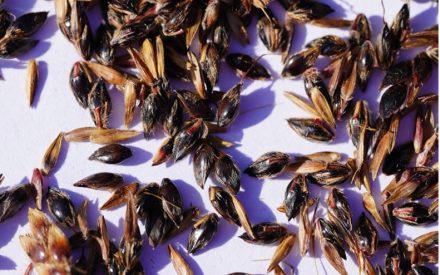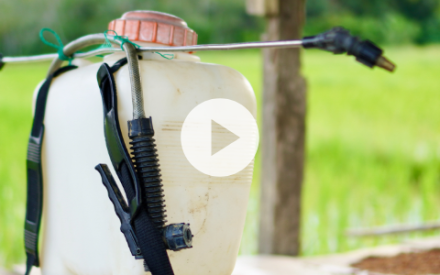What is an adjuvant?
An adjuvant is a supplemental substance added to a spray mixture to enhance the performance and/or physical properties of the desired chemical. Using the correct adjuvant can have benefits such as reducing or eliminating spray application problems, which would improve the overall efficacy of the applied formulation. Since adjuvants do not have pesticidal properties in their own right, they are not required to be registered by the U.S. Environmental Protection Agency (EPA) and the distribution of adjuvants is rarely regulated by the states. However, it is important to remember that adjuvants have labels that should be followed to avoid problems.
Formulation adjuvants and spray adjuvants
Adjuvants can fall into two categories: formulation adjuvants and spray adjuvants. Formulation adjuvants are added to the pesticide by the manufacturer and are inert ingredients on the label of the pesticides you purchase. Spray adjuvants are separate products added to the pesticide by the applicator, according to label instructions.
Before using any adjuvant products, please check the pesticide label first. Some labels have sections within the label for adjuvant use. Many pesticide labels have specific instructions on what type of adjuvant to use and how to use/mix it with the pesticide product. It is required to follow these instructions to be in compliance with the law. Although adjuvants do not have pesticidal properties, they are biologically active chemicals that can still have health risks. These products will have information on the label distinguishing the adjuvant’s level of toxicity, much like pesticides.
Adjuvants are designed to perform specific functions involving the mixing and application of pesticides such as dispersing, emulsifying, spreading, sticking, and wetting. They can also reduce evaporation, foaming, spray drift, and volatilization. There is not one single adjuvant that can perform all of these functions, but different types of adjuvants can be combined to perform several different functions. As a result, using adjuvants can help reduce application problems while increasing pesticide efficacy.
Adjuvant types
Spray adjuvants can be further divided into two groups: activator adjuvants and special-purpose adjuvants, also called utility adjuvants or spray modifiers.
Activator adjuvants
Activator adjuvants are designed to improve the activity of the pesticide. This is typically accomplished by reducing the surface tension on the leaf resulting in an increased absorption rate. It is common for postemergence herbicides to show increased activity when activator adjuvants are present or added. Activator adjuvants include surfactants, oils, and nitrogen-based fertilizers.
Surfactants: Surfactants change the physical properties of the spray solution and droplets. They can help improve the efficacy of the pesticide’s ability to emulsify, disperse, spread, and stick by reducing surface tension which increases a droplet’s ability to remain in contact with the leaf surface for longer periods of time. Increasing the duration a droplet is able to stay on the leaf surface allows for more pesticide to be absorbed by the leaf. Overall effectiveness is based on several factors including environmental conditions, plant features, and interactions between the surfactant, pesticide, and carrier.
Oils: Oils can increase the penetration of spray droplets and also help reduce surface tension. There are three types of oil-based adjuvants; crop oils, crop oil concentrates, and methylated seed oils. For example, crop oils are typically used with contact herbicides, like PPO inhibitors, to increase herbicide penetration within the plant and reduce surface tension for a more effective herbicide application. For more information on oils please reference the PennState Extension Article titled “Spray Adjuvants”.
Nitrogen-based fertilizers: The typical Nitrogen-based fertilizers used as adjuvants are Ammonium Sulfate (AMS) and Urea Ammonium Nitrate. These fertilizers may replace some adjuvants, but, when used with systemic pesticide products, are usually included as part of the tank mixture with a surfactant and a crop oil concentrate. In some cases, Ammonium Sulfate is used to reduce problems with hard water. Many fertilizer-based adjuvants are available as a liquid, which is easier for mixing and can provide more consistent results. Nitrogen-based fertilizers should only be used when recommended by the pesticide label.
Special-purpose or Utility adjuvants
Special-purpose adjuvants are used to fix specific conditions that can negatively affect the spray solution or application of the pesticide. Controlling or mitigating these factors can help maximize the efficiency of the pesticide. There are two groups of special-purpose adjuvants. One group of adjuvants is used to modify the physical characteristics of the spray solution which includes products such as defoaming agents, compatibility agents, buffering and conditional agents, deposition agents, and drift control agents. The second group of adjuvants helps minimize application issues which include products like foam markers, tank cleaners, and colorants. It is important to remember to read the label and carefully follow label instructions before adding any adjuvants into a spray mixture.
Compatibility agents: Since pesticides are commonly mixed with fertilizers and other pesticides, not all combinations are physically or chemically compatible. Incompatibility can be seen by product separation or clump formation in the spray tank. As a result, incompatible mixtures can clog the pump and hoses and can result in expensive cleanup and repairs. Utilizing a compatibility agent can help mitigate or eliminate these problems.
Deposition agents: Deposition agents, also known as “stickers,” can increase a pesticide’s ability to stick to a target’s surface. Ultimately, this decreases the amount of pesticide removed from plant surfaces through rain or irrigation.
Drift control agents and Thickeners: Drift control agents, such as drift retardants or deposition aids, can improve the placement of pesticide sprays by increasing the average droplet size. Typically, these adjuvants bind with water molecules to form larger spray droplets. One common spray mixture pairing is using a drift control agent with a volatile dicamba product to reduce the risk of herbicide drift. Similarly, thickeners can be used to increase the viscosity, or density, of spray mixtures to reduce drift and slow evaporation after pesticide application. This can be especially important when using systemic pesticides because it increases the length of time in which the pesticide can be absorbed by the plant.
Defoaming agents: Defoaming agents reduce or control the formation of foam in the spray tank. Typically, foam is created by air bubbles that form as a result of agitation and the type of surfactant used in the pesticide formula.
Buffering and Conditional agents: Buffer adjuvants are used to stabilize pH of the water in the spray mixture while acidifier adjuvants lower the pH of the water in the tank mix. Most pesticides perform better in slightly acidic conditions, though there are some exceptions. Pesticide mixtures with a pH level of 7 or above are at greater risk of breakdown. Many pesticides can lose efficacy relatively quickly in situations where the pH is not optimal. Conditional agents are used in situations where hard water is present as they reduce the issues caused by the minerals found in hard water, such as calcium and magnesium. As stated above, AMS is a common tank mix additive used to mitigate problems with hard water. It is important to remember that before using a buffer or conditional agent, consult the label for specific requirements for the pesticide and test the water for pH and hardness.
Foam markers: Foam markers are adjuvants that produce a foam mark when used with certain equipment. This is ultimately so the applicator knows where the product has been applied and in turn helps in avoiding skipping areas or overlapping areas that have already been sprayed.
Choosing the right adjuvant
When choosing the right adjuvant, please remember to:
- Read the pesticide label!
- Read the adjuvant label (if possible)
- Use only adjuvants that are labeled for agricultural or horticultural use
- If a pesticide label specifies a brand of adjuvant, that brand must be used as the label directs. Any substitution would be a violation of the label.
- Miracle adjuvants DO NOT exist. Buy products from a reputable dealer or with the Council of Producers and Distributors of Agrotechnology (CPDA) stamp of certification. For more information on CPDA please refer to the article from the UW-Madison Fruit Program, “Should you use an adjuvant with your insecticides?” by Cristelle Guédot.
- Adjuvant recommendations are subject to change due to alterations in the pesticide formulation. Always read the pesticide label before use!
- Adjuvants may not always be necessary. Some pesticide labels will not mention the use of an adjuvant. This can be due to the manufacturer’s research showing no benefits, or adverse effects, from use of adjuvants.


 ▶ Combine Cleaning: A Simple Step to Reduce Weed Seed Dispersal
▶ Combine Cleaning: A Simple Step to Reduce Weed Seed Dispersal Johnsongrass in Wisconsin
Johnsongrass in Wisconsin ▶ Backpack Sprayers in Diversified Vegetable Systems
▶ Backpack Sprayers in Diversified Vegetable Systems ▶ AI in Agriculture
▶ AI in Agriculture


